| BOSNA i HERCEGOVINA
| BOSNIA and HERZEGOVINA
|
| entitet: Federacija Bosne i Hercegovine
| entity: Federation of Bosnia and Herzegovina
|
| Kanton: Sarajevski
|
|
map →

Sarajevo
Сарајево
• fr: Saraiévo
• lv, sq: Sarajeva
• lt: Sarajevas
• de, pl: Sarajewo
• tr: Saraybosna
• hu: Szarajevó
• el: Σαράγεβο, Σεράγεβο
• be: Сараева
• bg, mk, ru: Сараево
• uk: Сараєво
• sr: Сарајево
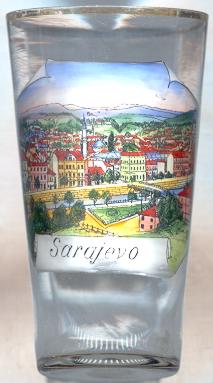
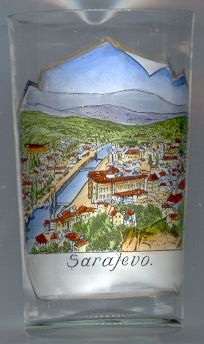 Sarajevo is situated at an elevation of 577 m on the river Miljacka in central Bosnia-Herzegovina.
The source of the river Bosna is located in the eastern town district of Ilidza.
Sarajevo is situated at an elevation of 577 m on the river Miljacka in central Bosnia-Herzegovina.
The source of the river Bosna is located in the eastern town district of Ilidza.
Slavs settled in this region in the Middle Ages. The first mention of Bosnia is found in a document of the mid-10th century.
From the 12th century Bosnia became more and more independent from the Hungarian and Croat rulers. The center
of Bosnia was located in the Sarajevo valley. Vrhbosna was first mentioned in 1244 but its exact location
is still unclear. Late Turkish sources suggest that there were several settlements in this area.
Sarajevo was first mentioned in a document of 1415. In 1463 it came under the rule of the Ottoman Empire
and remained so for the following almost 400 years. The turkish name during that period was Saraybosna.
Towards the end of that period, in 1850, Sarajevo became the capital of Bosnia. After the Treaty of
Berlin, Bosnia and Herzegovina were occupied by Austria-Hungary in 1878,
annexed in 1908, and remained part of the Habsburg monarchy until 1918. On the 28th of June 1914 Sarajevo
was the site of the assassination of the Autrian Successor to the Throne, Archduke Franz Ferdinand,
and his wife, Sophie née Countess Chotek styled Duchess of Hohenberg (see also
Artstetten), by the Bosnian Serb anarchist Gavrilo Princip.
After World War I Sarajewo in 1918 became part of the Kingdom of Serbs, Croats and Slovenes.
Between 1941 and 1945 it was part of the 'Independent State of Croatia'. After World War II
it became the capital of the Republic of Bosnia and Herzegovina within Yugoslavia. During the Balkan War
Sarajevo was besieged by Serb forces for 1,425 days, from the 5th of April 1992 until the 29th of February 1996,
the longest siege in history. During this period almost 11,000 people including 1,600 children were killed.
Today Sarajevo is the capital of Bosnia and Herzegovina and of the Bosnian-Croation Federation of Bosnia
and Herzegovina.
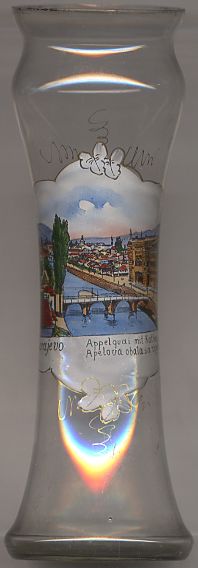
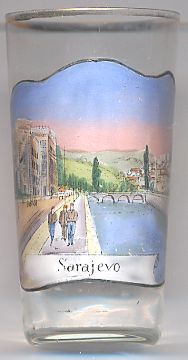
The building shown on the far left of the picture on glass no. 2436 [right] and on the far right of the picture on glass no. 2638 [left]
was built in 1892–1894 by the Austrian architect Alexander Wittek as Sarajevo's
 city hall (vijećnica). Although the city's administration moved in immediately, the official opening took place only in 1896.
Apart from the city administration, the city hall housed the District Court for a time and, from 1910 to 1914, the Parliament of
Bosnia and Herzegovina was also there. The street in front of the city hall along the river is
Apelova obala (German: Appelquai); it was on this street that Archduke Franz-Ferdinand of Austria was assassinated on 28th June 1914
after leaving from a reception in the city hall. Today, the street is named Obala Kulina bana, named for Kulin, a powerful Ban of Bosnia, who ruled Bosnia from 1180 to 1204,
first as a vassal of the Byzantine Empire and then of the Kingdom of Hungary.
Since 1949 the former city hall was used as National and University Library.
As the National Library, it contained holdings of Bosniaca, publications and manuscripts either written and published in Bosnia and Herzegovina or written by Bosnian
and Herzegovinian writers (more than 1,200,000 units), holdings of periodicals in 33,000 volumes (1854–1941), a department of Rare Books and Manuscripts with
collections which held the four incunabula, the collection of rare books handwritten in Bosančica, the collection of oriental manuscripts with about 400 codes
and 700 individual documents, manuscripts of local authors written in oriental languages, etc. During the siege of Sarajevo by Serbian forces, in just one night of
25th to 26th August 1992, 90 per cent of the total library holding was destroyed and this beautiful and precious cultural monument devastated.
A complete restoration according to the original design is planned.
[Text adapted from http://www.sarajevo.ba/en/stream.php?kat=149]
city hall (vijećnica). Although the city's administration moved in immediately, the official opening took place only in 1896.
Apart from the city administration, the city hall housed the District Court for a time and, from 1910 to 1914, the Parliament of
Bosnia and Herzegovina was also there. The street in front of the city hall along the river is
Apelova obala (German: Appelquai); it was on this street that Archduke Franz-Ferdinand of Austria was assassinated on 28th June 1914
after leaving from a reception in the city hall. Today, the street is named Obala Kulina bana, named for Kulin, a powerful Ban of Bosnia, who ruled Bosnia from 1180 to 1204,
first as a vassal of the Byzantine Empire and then of the Kingdom of Hungary.
Since 1949 the former city hall was used as National and University Library.
As the National Library, it contained holdings of Bosniaca, publications and manuscripts either written and published in Bosnia and Herzegovina or written by Bosnian
and Herzegovinian writers (more than 1,200,000 units), holdings of periodicals in 33,000 volumes (1854–1941), a department of Rare Books and Manuscripts with
collections which held the four incunabula, the collection of rare books handwritten in Bosančica, the collection of oriental manuscripts with about 400 codes
and 700 individual documents, manuscripts of local authors written in oriental languages, etc. During the siege of Sarajevo by Serbian forces, in just one night of
25th to 26th August 1992, 90 per cent of the total library holding was destroyed and this beautiful and precious cultural monument devastated.
A complete restoration according to the original design is planned.
[Text adapted from http://www.sarajevo.ba/en/stream.php?kat=149]
The bridge depicted on the right of the picture is the
 Šeher-Ćehajin bridge (Šeher-Ćehajina ćuprija)
across the river Miljacka. It was built in 1585/1586 and spans the river between the slopes of the Nadmlina and Alifakovac hills.
The name suggests that it was either built or rebuilt (renovated) by one of Sarajevo's šeher-ćehajas (mayors).
The bridge was probably rebuilt after the disastrous flood that befell Sarajevo in 1619/20, when six bridges, including the Šeher-Ćehajina, were swept away.
Major changes to the bridge were made during the regulation in 1897 of the channel of the river Miljacka.
One of the five arches of the bridge, the one on the left bank of the Miljacka, was buried under the embankment,
and in 1904 the stone parapet of the bridge was removed and consol-supported footways with an iron railing were added.
In 2005 the bridge was designated as a National Monument of Bosnia and Herzegovina.
[Text adapted from http://www.aneks8komisija.com.ba/main.php?id_struct=50&lang=4&action=view&id=2524]
Šeher-Ćehajin bridge (Šeher-Ćehajina ćuprija)
across the river Miljacka. It was built in 1585/1586 and spans the river between the slopes of the Nadmlina and Alifakovac hills.
The name suggests that it was either built or rebuilt (renovated) by one of Sarajevo's šeher-ćehajas (mayors).
The bridge was probably rebuilt after the disastrous flood that befell Sarajevo in 1619/20, when six bridges, including the Šeher-Ćehajina, were swept away.
Major changes to the bridge were made during the regulation in 1897 of the channel of the river Miljacka.
One of the five arches of the bridge, the one on the left bank of the Miljacka, was buried under the embankment,
and in 1904 the stone parapet of the bridge was removed and consol-supported footways with an iron railing were added.
In 2005 the bridge was designated as a National Monument of Bosnia and Herzegovina.
[Text adapted from http://www.aneks8komisija.com.ba/main.php?id_struct=50&lang=4&action=view&id=2524]
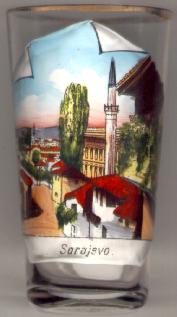
Glass no. 410 [left] shows the
 Gazi Husrev Beg mosque (Gazi Husrev-begova džamija).
It was built in 1531 and is one of the main Ottoman complexes in the Balkans.
Gazi Husrev Beg (1480–1541) was Ottoman governor of Sarajevo and contributed greatly to its urban development.
The mosque was constructed by Ajem Esir Ali, an architect from Tabriz who had been taken prisoner
during Ottoman incursions into Persia and became a chief architect in Istanbul.
The mosque in Sarajevo is among the successes of this school outside Constantinople.
During the Balkan War of 1992–1995 the mosque was heavily damaged but was restored after the war.
During these restaurations, however, the original decorations were removed according to the ideals of Wahhabist islam,
which caused international outcry. Currently, new restauration efforts aim at restoring the mosque's original state.
Gazi Husrev Beg mosque (Gazi Husrev-begova džamija).
It was built in 1531 and is one of the main Ottoman complexes in the Balkans.
Gazi Husrev Beg (1480–1541) was Ottoman governor of Sarajevo and contributed greatly to its urban development.
The mosque was constructed by Ajem Esir Ali, an architect from Tabriz who had been taken prisoner
during Ottoman incursions into Persia and became a chief architect in Istanbul.
The mosque in Sarajevo is among the successes of this school outside Constantinople.
During the Balkan War of 1992–1995 the mosque was heavily damaged but was restored after the war.
During these restaurations, however, the original decorations were removed according to the ideals of Wahhabist islam,
which caused international outcry. Currently, new restauration efforts aim at restoring the mosque's original state.
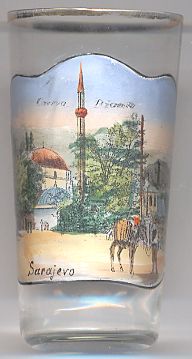
Glass no. 2437 [near left] shows the
 Emperor's mosque (Careva džamija), named after Sultan Suleiman I (Suleiman the Magnificent),
the tenth and longest-reigning Sultan of the Ottoman Empire, from 1520 to his death in 1566.
The mosque was constructed in 1566 in place of an older, wooden mosque of 1457, which had been the first in Sarajevo.
A thorough renovation was carried out in 1912.
During Restoration works in the 1980s and 1990s, several layers of decorations from the 16th, 18th and early 19th century were discovered.
The octogonal minaret (munara) is one of the most beautiful in Bosnia and Hercegovina.
Emperor's mosque (Careva džamija), named after Sultan Suleiman I (Suleiman the Magnificent),
the tenth and longest-reigning Sultan of the Ottoman Empire, from 1520 to his death in 1566.
The mosque was constructed in 1566 in place of an older, wooden mosque of 1457, which had been the first in Sarajevo.
A thorough renovation was carried out in 1912.
During Restoration works in the 1980s and 1990s, several layers of decorations from the 16th, 18th and early 19th century were discovered.
The octogonal minaret (munara) is one of the most beautiful in Bosnia and Hercegovina.
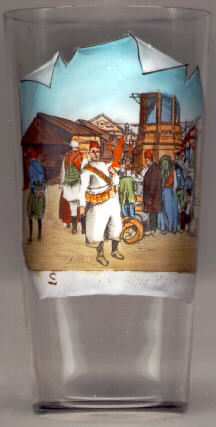
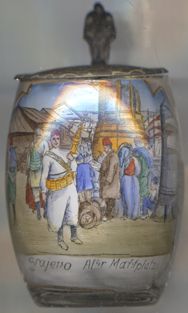
Glasses no. 217 [far left] and no. 4494 [near left] show the
 old market of Sarajevo.
old market of Sarajevo.
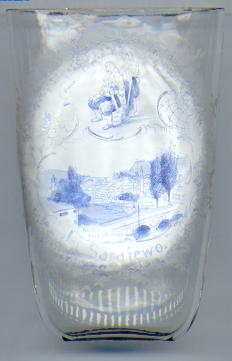
Glass no. 628 [right] shows the Bosnian graveyard on
 Alifakovac hill.
The graveyard dates from the 18th century and is one of the most beautiful examples of memorial architecture
and stonemasonry in Bosnia.
Alifakovac hill.
The graveyard dates from the 18th century and is one of the most beautiful examples of memorial architecture
and stonemasonry in Bosnia.
![[scale]](lineal.jpg)



 Sarajevo is situated at an elevation of 577 m on the river Miljacka in central Bosnia-Herzegovina.
The source of the river Bosna is located in the eastern town district of Ilidza.
Sarajevo is situated at an elevation of 577 m on the river Miljacka in central Bosnia-Herzegovina.
The source of the river Bosna is located in the eastern town district of Ilidza.


 city
city Šeher-Ćehajin
Šeher-Ćehajin
 Gazi
Gazi
 Emperor's
Emperor's

 old
old
 Alifakovac
Alifakovac![[scale]](lineal.jpg)